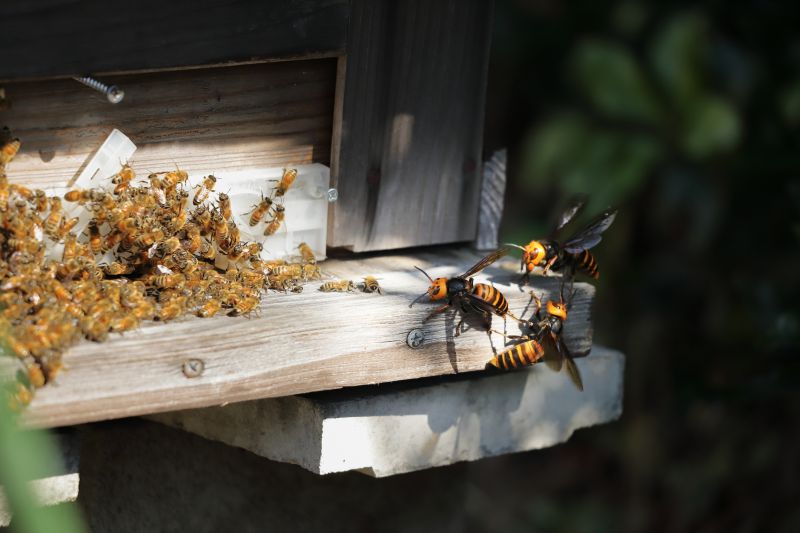Top-Rated Solutions For Bee And Wasp Nests Removal
Identify highly effective products designed to target and eliminate bee and wasp nests safely and efficiently.
 Effective management of bee and wasp issues often involves the use of specialized removal products designed to address nests and prevent unwanted encounters. These products vary widely in their application methods, from aerosol sprays to physical traps, each suited to different scenarios and levels of infestation. When selecting a product, it is important to consider the safety of surrounding environments, ease of use, and the specific type of pest you are targeting.
Effective management of bee and wasp issues often involves the use of specialized removal products designed to address nests and prevent unwanted encounters. These products vary widely in their application methods, from aerosol sprays to physical traps, each suited to different scenarios and levels of infestation. When selecting a product, it is important to consider the safety of surrounding environments, ease of use, and the specific type of pest you are targeting.
Top Overall Option
Aerosol Spray for Bee and Wasp Control
Aerosol sprays designed for bee and wasp control are versatile tools that allow for targeted application directly onto nests or insects. They typically feature a long-reaching nozzle for safety and precision, enabling users to treat nests from a safe distance. These products often contain fast-acting formulas intended to disable insects quickly while allowing for safe removal of nests afterward. They are suitable for various outdoor and indoor applications and can be stored for future use. Proper usage involves identifying active nests and applying the spray during appropriate times of day to maximize effectiveness.
Types of Products For Bee And Wasp Removals
Aerosol Spray
Portable and easy to use, aerosol sprays provide targeted treatment for nests and insects, often with long-range nozzles for safety.
Wasp Traps
Physical traps attract and capture wasps using baited containers, helping to reduce local populations.
Nest Removal Kits
Complete kits that include tools and solutions for safe removal and disposal of nests.
Wasp Decoys
Decoys mimic nests to deter wasps from establishing new colonies in the area.
Insecticidal Dusts
Powder formulations that can be applied directly into nests or cracks to eliminate hidden colonies.
Protective Clothing
Specialized suits and gloves designed for safe application of removal products in active nests.
UV Light Traps
Electronic devices that attract insects using UV light and trap them for disposal.
Chemical Baits
Lure-based solutions that attract and poison wasps or bees over time.
Repellent Sprays
Sprays that discourage insects from settling in specific areas, providing a preventive barrier.
Electric Swatters
Handheld devices for quick and safe elimination of individual insects.
Popular Choices
A widely used trap that attracts wasps with bait and captures them effectively outdoors.
Commonly chosen for its ease of use and quick action on active nests.
Popular among homeowners for safe removal of nests with included tools and solutions.
Decoys used to deter wasps from building new nests in problematic areas.
Electronic trap attracting insects with UV light, effective for indoor and outdoor use.
Powdered insecticide applied directly into nests to target hidden colonies.
Essential gear for safely handling active nests and applying treatments.
Bait stations that attract and poison wasps over time, reducing populations.
Spray formulations used to create a barrier against wasps in outdoor spaces.
Handheld or stationary devices that electrocute individual insects on contact.
Many removal solutions are formulated to provide quick and targeted action, helping to reduce the presence of these insects around residential or commercial properties. Proper application techniques and the timing of treatment can significantly influence the effectiveness of these products. It is recommended to follow manufacturer instructions carefully to ensure safety and optimal results.
In addition to chemical options, there are physical barriers and traps that can serve as preventative measures. These products work by either capturing insects before they establish a nest or by discouraging their activity in specific areas. Combining different types of products can offer a comprehensive approach to managing bee and wasp populations, especially during peak seasons.
Choosing the right product involves understanding your specific needs, such as whether you are dealing with a visible nest, a recurring problem, or a preventive measure for outdoor spaces. Regular monitoring and timely intervention can help maintain a safe environment while minimizing disturbance to beneficial insects that play essential roles in pollination and ecological balance.
Key Buying Considerations
- Identify whether you are dealing with a visible nest or just individual insects.
- Determine the type of pest to select the most appropriate product for bees or wasps.
- Consider safety features such as long nozzles or protective gear for handling active nests.
- Evaluate whether a physical trap or chemical solution best suits your situation.
- Check the coverage area of the product to ensure it is suitable for your space.
- Review application instructions carefully to ensure correct and safe usage.
- Assess the ease of use and whether the product is suitable for DIY treatment or professional intervention.
- Consider the longevity and durability of traps and repellents for ongoing protection.
- Look into whether the product is designed for indoor, outdoor, or both environments.
- Review any necessary disposal or cleanup procedures after treatment.
- Be aware of the active ingredients and potential safety precautions for household use.
- Evaluate customer feedback and ratings for insights into product effectiveness.
- Consider the seasonality of your problem to choose products that work best during peak activity times.
- Determine if the product includes or requires personal protective equipment.
- Think about the environmental conditions, such as wind or rain, that might affect product performance.
